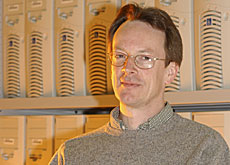CERN sends data on the Internet at record speeds

The Geneva-based European Organization for Nuclear Research, which is known by its French acronym CERN, has achieved yet another first using Internet technology. This time it is a speed record.
Running data over the new Internet2, CERN and California Institute of Technology (Caltech) have set a new Internet speed record.
This is the third time in the past year.
The latest record is 6.25 gigabits per second over an 11,000 km “course”.
This is some 10,000 times faster and a much greater distance, from Geneva to California, compared to a broadband Internet connection to the home, which manages only about 2 megabits per second and has to travel one or two kilometers maximum.
The need for speed is driven by CERN’s grid computing project. Grid computing, also known as cluster computing or distributed processing, offers a lower cost way to crunch the numbers buried in the vast amounts of data generated by CERN’s physics experiments.
It creates a supercomputer based on utilizing processors lodged in idle PCs and computing centers around the world connected to each other via the Internet at high speeds.
CERN is part of the European Union funded effort called DATAGrid which involved massive software development over a number of years and is now in place.
The second phase of the project, Enabling Grids for E-Science in Europe (EGEE) project, began last month.
“This new multi-stream record is an important step towards next generation Grids where scientists are able to share an ensemble of links based on 10 gigabit per second optical wavelengths efficiently… In order to realize this vision, we are now working on moving these developments into a production setting,” said Harvey Newman, Professor of Physics at Caltech in a press announcement.
Once CERN’s newest experiment in the Large Hadron Collider experiment is underway, the volume of data generated will be enormous.
In order to find the particles relevant to the research massive computer processing power is required.
But because CERN has a relatively tiny budget for computing, it has had to be creative.
It is an early adopter, even an innovator, of Internet technologies.
CERN researchers created the World Wide Web so that particle physicists could share data and research results in a standardized way with collaborators around the world, without spending a fortune on data communications, networking, and proprietary desktop publishing tools.
With its open infrastructure, the Internet offers project teams a low-cost alternative to many proprietary software and networking systems.
Several major international Grid development projects are underway at present both within the European Community, and in the USA.
All of these projects are working towards the common goal of providing transparent access to the massively distributed computing infrastructure that is needed to meet the challenges of modern data intensive applications.
And it is not just physics researchers in Switzerland leading the way, pharmaceutical companies are active as well.
Basel-based pharmaceutical giant Novartis AG is using the technology to process data used for designing new drugs.
It is working closely with Intel and has recently standardized some 2,700 PCs to the Pentium 4 processor platform and linked them to a high performance grid that works in the same way that CERN’s does.
Novartis has made a series of announcements, suggesting that it too will become a leader in adopting this new technology.
swissinfo, Valerie Thompson

In compliance with the JTI standards
More: SWI swissinfo.ch certified by the Journalism Trust Initiative








You can find an overview of ongoing debates with our journalists here . Please join us!
If you want to start a conversation about a topic raised in this article or want to report factual errors, email us at english@swissinfo.ch.